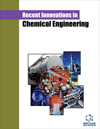- Home
- A-Z Publications
- Recent Innovations in Chemical Engineering (Formerly Recent Patents on Chemical Engineering)
- Previous Issues
- Volume 17, Issue 4, 2024
Recent Innovations in Chemical Engineering (Formerly Recent Patents on Chemical Engineering) - Volume 17, Issue 4, 2024
Volume 17, Issue 4, 2024
-
-
Advances in Monazite Decomposition Technologies: Proposed Potential Direction for the Sodium Hydroxide Leaching Context
More LessAuthors: Hoang Xuan Thi, Hoang Nhuan, Ngo Van Tuyen, Vuong Huu Anh and Nguyen Huu DucThe current understanding and development of monazite decomposition technology using sodium hydroxide are examined. Most previous assessments have primarily focused on the post-leaching processing of monazite using sodium hydroxide, including processing steps to produce the total rare earth oxide product. However, the initial leaching process of monazite with alkali solution proves to be highly significant in Read More
-
-
-
A Mini Review on the Opportunities for Membrane Pervaporation Technology for Energy-efficient Removal of Dispersed Oil and Dissolved Hydrocarbons from Produced Water
More LessProduced water is reported to have the largest volume of waste stream associated with hydrocarbon recovery. It was estimated to increase from 250 million B/D in 2007 to more than 300 million B/D between 2010 and 2012. Market research conducted by Adroit put the globally produced water treatment market at a value of USD 5.10 billion in 2022. This value is anticipated to be USD 9.80 billion in 2032 at a compound an Read More
-
-
-
Forecasting the Corrosion Fatigue Life of Structural Materials in Chemical Engineering
More LessIntroduction The most important task in the development of modern chemical engineering is to improve the quality of metal products and parts made from them, increase their efficiency, reliability, and fatigue life, bring these indicators to the level of world standards, and ensure the competitiveness of domestic products in the foreign market. The structural safety of chemical engineering equipment is largely determi Read More
-
-
-
Kinetic Adsorption Studies of Cationic Dyes onto Molecular Sieve and Activated Carbons
More LessAuthors: Lei Rong, Guanjie Tao, Xiaoxiao He, Zitian Meng, Nady Fathy, and and Yousheng TaoBackground Dye-containing wastewater causes irreparable damage to the ecological water system. Although adsorbents are widely used for treating wastewater containing dyes, the comparative investigation on these materials is still insufficient for their wide applications in the industries. Objective With the aim of comparing efficient and fast adsorbent materials for cationic dyes, we analyzed and evaluated the adsorbents Read More
-
-
-
Inhibition of Subsequent Commutation Failures in Ultra-High Voltage Direct Current Transmission Systems Using Electrochemical Energy Storage at the Sending End
More LessAuthors: Wenhui Wang and Yefei XuIntroduction Subsequent commutation failures (SCFs) in high-voltage direct current (HVDC) systems pose a serious threat to the safe operation of hybrid AC/DC grids. Electrochemical energy storage, which is widely distributed at the sending end of ultra-high voltage direct current (UHVDC) transmission systems, has the potential to mitigate SCFs. To fully harness the SCF-mitigating capabilities of energy storage, this article fir Read More
-
-
-
Worldwide Research Trend on Steel Casting: A Visualization and Future Research Directions
More LessAims In this study, we conducted a bibliometric study about steel casting between the year 2000-2023. We carried out a bibliometric analysis of sand casting, investment casting, die casting, and squeeze casting in which optimization and simulation models are available and have been thoroughly developed to enhance the quality of the casting product, according to the keyword co-occurrence network and word cloud g Read More
-
Most Read This Month
Article
content/journals/rice
Journal
10
5
false
en


